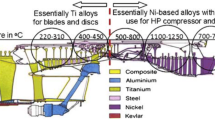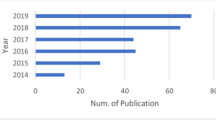Abstract
Titanium and its alloys are attractive materials due to their unique high strength–weight ratio that is maintained at elevated temperatures and their exceptional corrosion resistance. The major application of titanium has been in the aerospace industry. On the other hand, titanium and its alloys are notorious for their poor thermal properties and are classified as difficult-to-machine materials. The problems that arise during grinding of titanium alloys are attributed to the high specific energy and high grinding zone temperature. Significant progress has been made in dry and semidry machining recently, and minimal quantity lubrication (MQL) machining in particular has been accepted as a successful semidry application because of its environmentally friendly characteristics. A number of studies have shown that MQL machining can show satisfactory performance in practical machining operations. However, there has been few investigation of MQL grinding of special alloys like titanium alloys and the cutting fluids to be used in MQL grinding of these alloys. In this study, vegetable and synthetic esters oil are compared on the basis of the surface quality properties that would be suitable for MQL applications. The cutting performance of fluids is also evaluated using conventional wet (fluid) grinding of Ti–6Al–4V. As a result, synthetic ester oil is found to be optimal cutting fluids for MQL grinding of Ti–6Al–4V.
Similar content being viewed by others
References
Silva LR, Bianchi EC, Catai RE, Fusse RY, FranÇa TV, Aguiar PR (2005) Study on the behavior of the minimum quantity lubricant-MQL technique under different lubrication and cooling conditions when grinding ABNT 4340 steel. J Braz Soc Mech Sci & Eng XXVII:192–199
Silva LR, Bianchi EC, Fusse RY, Catai RE, FranÇa TV, Aguiar PR (2007) Analysis of surface integrity for minimum quantity lubricant-MQL in grinding. Int J Machine Tools Manuf 47:412–418
Sahm D, Schneider T (1996) The production without coolant is interesting and must be more known. Machines and Metals Magazine 367:38–55
Dunlap C (1997) Should you try dry. Cutt Tool Eng 49:22–33
Klocke F, Schulz A, Gerschwiler K, Rehse M (1998) Clean manufacturing technologies—the competitive edge of tomorrow. The Int J Manuf Sci Production 1:77–86
Novaski O, Dörr J (1999) Usinagem sem refrigeração. Máquinas e Metais 18–27
Machado A R, Diniz A E (2000) Advantages and disadvantages of the use of the cutting fluids. Proc. Machining Congress, São Paulo, SP, Brazil
Klocke F, Eisenblätter G (1997) Dry cutting. Ann CIRP 46:519–526
Brockhoff T, Walter A (1998) Fluid minimization in cutting and grinding. Abras Magazine 38–42
Simon T A (1999) The current stage of the technology of the machines-tool. Machines and Metals Magazine 88–108
Dörr J, Sahm A (2000) The minimum quantity lubricant evaluated by the users. Machines and Metals Magazine 418:20–39
Young P, Byrne G, Cotterell M (1997) Manufacturing and the environment. The Int J Advan Manuf Technol 13:488–493
Heisel U, Lutz D, Wassmer R, Walter U (1998) The minimum quantity lubricant technique and its application in the cutting process. Machines and Metals Magazine 386:22–38
Schulz H (1999) Trends in manufacturing technology at the threshold of the millennium, Fourth International Congress of High Technology—Technological Innovations in the Manufacture, Unimep, Piracicaba, SP, Brazil
Diniz AE (1999) Minimal lubrication in the drilling process of aluminum silicon alloy, 3rd International Machining & Grinding Conference, pp 683–697
Hafenbraedl D, Malkin S (2001) Technology environmentally correct for intern cylindrical grinding. Machines and Metals Magazine 426:40–55
Ezugwu EO (2004) High speed machining of aero-engine alloys. J Braz Soc Mech Sci & Eng XXVI:1–11
López de lacalle LN, Pérez J, LIarente JI, Sánchez JA (2000) Advanced cutting conditions for the milling of aeronautical alloys. J Mater Process Technol 100:1–11
Ezugwu EO (2005) Key improvements in the machining of difficult-to-cut aerospace superalloys. Int J Mach Tools Manuf 45:1353–1367
Marinescu ID, Rowe WB, Dimitrov B, Inasaki I (2004) Tribology of abrasive machining process. William Andrew, Norwich
Turley DM (1985) Factors affecting finishing when grinding titanium and a titanium alloy(Ti–6Al–4V). Wear 104:323–335
Tawakoli T, Westkaemper E, Rabiey M (2007) Dry grinding by special conditioning. Int J Adv Manuf Technol 33:419–424
Tawakoli T (1993) High efficiency deep grinding, VDI and Mechanical Engineering Publications Limited (MEP), ISBN 0852988206
Klocke F, Beck T, Eisenblatter G, Fritsch R, Lung D, Pohls M (2000) Applications of minimal quantity lubrication (MQL) in cutting and grinding. In: Proceeding of the 12th International Colloquium Industrial and Automotive Lubrification, Technische Akademie, Esslingen, pp 11–13 January (2000)
Ezugwu EO, Bonney J, Da silva RB, Çakir O (2007) Surface integrity of finished turned Ti–6Al–4V alloy with PCD tools using conventional and high pressure coolant supplies. Int J Mach Tools Manuf 47:884–891
Ivasishin OM, Teliovich RV (1999) Potential of rapid heat treatment of titanium alloys and steels. Mater Sci Eng A. 263:142–154
Malkin S (1989) Grinding technology: theory and applications of machining with abrasives, 1st edn. Ellis Horwood, Chichester
Tawakoli T, Westkämper E, Rabiey M, Rasifard A (2007) Influence of the type of coolant lubricant in grinding with CBN tools. Int J Machine Tools Manuf 45:734–739
Author information
Authors and Affiliations
Corresponding author
Rights and permissions
About this article
Cite this article
Sadeghi, M.H., Haddad, M.J., Tawakoli, T. et al. Minimal quantity lubrication-MQL in grinding of Ti–6Al–4V titanium alloy. Int J Adv Manuf Technol 44, 487–500 (2009). https://doi.org/10.1007/s00170-008-1857-y
Received:
Accepted:
Published:
Issue Date:
DOI: https://doi.org/10.1007/s00170-008-1857-y




